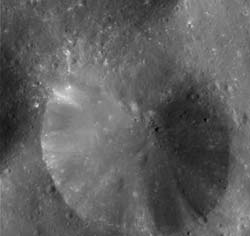Crater on Phoebe in close-up

Credits: NASA/JPL/Space Science Institute
This amazing high-resolution image of Phoebe’s pitted surface was taken very near the closest approach by the NASA/ESA/ASI Cassini-Huygens spacecraft.
It shows a crater with a diameter of 13 kilometres and a debris-covered floor. Part of another crater of similar size is visible at left, as is part of a larger crater at the top and many scattered smaller craters.
The radial streaks in the crater are due to downslope movements of loose fragments from impact ejecta (material thrown out by impacts). Also seen are boulders ranging from about 50 to 300 metres in diameter.
These ’building-sized’ rocks may have been excavated by large impacts, perhaps from some other region of Phoebe rather than the craters seen here. There is no visible evidence for layering of ice and regolith (or a hardened crust, or mantle) in this region, as on other parts of this moon.
Some of the relatively bright spots are from small impacts that excavated bright material from beneath the dark surface. Images like this provide information about impact and regolith processes on Phoebe.
The Cassini-Huygens mission is a co-operative project of NASA, ESA and the Italian Space Agency.
Media Contact
More Information:
http://www.esa.int/SPECIALS/Cassini-Huygens/SEMBZ33VQUD_0.htmlAll latest news from the category: Physics and Astronomy
This area deals with the fundamental laws and building blocks of nature and how they interact, the properties and the behavior of matter, and research into space and time and their structures.
innovations-report provides in-depth reports and articles on subjects such as astrophysics, laser technologies, nuclear, quantum, particle and solid-state physics, nanotechnologies, planetary research and findings (Mars, Venus) and developments related to the Hubble Telescope.
Newest articles

Superradiant atoms could push the boundaries of how precisely time can be measured
Superradiant atoms can help us measure time more precisely than ever. In a new study, researchers from the University of Copenhagen present a new method for measuring the time interval,…

Ion thermoelectric conversion devices for near room temperature
The electrode sheet of the thermoelectric device consists of ionic hydrogel, which is sandwiched between the electrodes to form, and the Prussian blue on the electrode undergoes a redox reaction…

Zap Energy achieves 37-million-degree temperatures in a compact device
New publication reports record electron temperatures for a small-scale, sheared-flow-stabilized Z-pinch fusion device. In the nine decades since humans first produced fusion reactions, only a few fusion technologies have demonstrated…





















